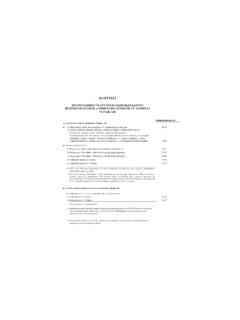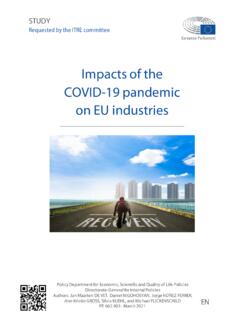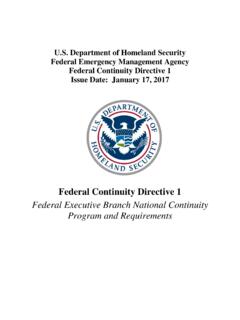Transcription of Risk and Crisis Management in Tourism Sector: Recovery ...
1 Risk and Crisis Management in Tourism sector : Recovery From Crisis in the OIC Member Countries Recovery COMCEC COORDINATION OFFICE. August 2017. Risk & Crisis Management in Tourism sector : Recovery From Crisis in the OIC Member Countries COMCEC COORDINATION OFFICE. August 2017. This report has been commissioned by the COMCEC Coordination Office to Tourism Development International. Views and opinions expressed in the report are solely those of the author(s) and do not represent the official views of the COMCEC Coordination Office or the Member States of the Organization of Islamic Cooperation. Excerpts from the report can be made as long as references are provided. All intellectual and industrial property rights for the report belong to the COMCEC. Coordination Office.
2 This report is for individual use and it shall not be used for commercial purposes. Except for purposes of individual use, this report shall not be reproduced in any form or by any means, electronic or mechanical, including printing, photocopying, CD recording, or by any physical or electronic reproduction system, or translated and provided to the access of any subscriber through electronic means for commercial purposes without the permission of the COMCEC Coordination Office. For further information, please contact: COMCEC Coordination Office Necatibey Caddesi No: 110/A. 06100 Y cetepe Ankara/TURKEY. Phone: 90 312 294 57 10. Fax: 90 312 294 57 77. Web: RISK & Crisis Management IN. Table of Contents Page No EXECUTIVE SUMMARY .. 1. 1. Tourism Risk and Crisis Management Frameworks.
3 1. 2. Types and impacts of Crises in 2. 3. Mitigation and Response Strategies and Actions .. 5. 4. Case Studies .. 12. INTRODUCTION .. 14. 1. CONCEPTUAL FRAMEWORK: Risk and Crisis Management .. 17. Crisis and Disaster .. 17. Risk 18. Tourism Crisis Management Frameworks .. 19. The Tourism resilience Cycle .. 21. Types of Crisis in 24. Impacts of Crises and Recovery in the Tourism 29. The Role of Media and Travel Advisories .. 33. 36. 2. MITIGATION STRATEGIES AND ACTIONS .. 37. Tourism Crisis Management and Disaster Risk Reduction Strategies .. 37. Key Organisations and Roles in Tourism Crisis 38. Tourism Crisis Responses: Strategies and Actions .. 40. Crisis Communications .. 53. 55. 3. Tourism sector CRISES IN OIC MEMBER STATES .. 57. Types of Crisis Faced by OIC Countries.
4 57. Impact of Crises on OIC Member States' Tourism Sectors .. 60. Response Strategies and Actions: During and Post Crises .. 61. 65. i 4. CASE STUDIES OIC Countries .. 66. Case Study 1 Indonesia (Field study) .. 66. Case Study 2 Turkey (Field study) .. 78. Case Study 3 Tunisia (Field study) .. 86. Case Study 4 The Gambia (Desk study) .. 94. 5. CASE STUDIES Non-OIC Countries .. 99. Case Study 1 South Africa (Field study) .. 99. Case Study 2 United Kingdom (Desk study) .. 108. Case Study 3 Thailand (Desk Study) .. 116. Case Study 4 Sri Lanka (Desk study) .. 125. 6. POLICY RECOMMENDATIONS .. 134. Introduction .. 134. Conclusions from the Case Studies .. 134. Public and Third sector Responses and resilience .. 136. Private sector Responses and resilience .. 143.
5 Concluding Remarks .. 149. REFERENCES. ii List of Tables Table : Crisis Management Framework .. 20. Table : Crisis Recovery Time .. 32. Table : Reasons for effectiveness of measures taken by own Organization .. 45. Table : Test messages aimed at revitalising Tourism to bushfire affected area of Australia .. 50. Table : Principles of Crisis 54. Table : Before Crisis : preparing for the worst .. 55. Table : During a Crisis .. 56. Table : Following a Crisis : rebuilding tourist confidence .. 56. Table : Environmental Crises affecting Tourism in OIC Countries .. 58. Table : Societal/Political Crises affecting Tourism in OIC Countries .. 58. Table : Health-Related Crises affecting Tourism in OIC Countries .. 59. Table : Technological Crises affecting Tourism in OIC Countries.
6 59. Table : Economic Crises affecting Tourism in OIC 60. Table : International Visitor Arrivals and Foreign Exchange Earnings - 68. Table : International Visitor Arrivals and Foreign Exchange Earnings - Turkey .. 80. Table : International Visitor Arrivals and Foreign Exchange Earnings - 87. Table : International Visitor Arrivals and Foreign Exchange Earnings The Gambia .. 95. Table : International Visitor Arrivals and Foreign Exchange Earnings South Africa .. 100. Table : International Visitor Arrivals and Foreign Exchange Earnings - UK .. 109. Table : International Visitor Arrivals and Foreign Exchange Earnings - 117. Table : International Visitor Arrivals and Foreign Exchange Earnings Sri Lanka .. 127. iii List of Figures Figure : Crisis Management Framework.
7 2. Figure : Key Actions in the Six Phases of Crisis Management .. 10. Figure : Disaster Risk Management Strategy .. 18. Figure : The resilience Cycle or Holling Loop' .. 21. Figure : Sensitivity of Tourism markets to Crisis .. 29. Figure : Length of time taken for own organisation to recover from 33. Figure : Growth (decline) in International & Domestic Tourism to Indonesia 2000-10 .. 71. Figure : Crisis Management after 2002 Bombings in Bali .. 72. Figure : Indonesia's Nine Steps to Tourism Crisis Recovery ' .. 73. Figure : Crisis Management Scheme for Tourism .. 74. Figure : Arrivals to South Africa from Outside Africa, 2005-15 .. 101. Figure : International Tourism Arrivals to Sri Lanka, 128. iv List of Abbreviations ASATA Association of South African Travel Agents ASEAN Association of Southeast Asian Nations ASSET Association of Small Scale Enterprises in Tourism BSA Brand South Africa CAST Caribbean Alliance for Sustainable Tourism CDEM Civil Defence and Emergency Management CDERA Caribbean Disaster Emergency Response Agency CMSC Culture.
8 Media and Sport Committee COMCEC Standing Committee for Economic and Commercial Cooperation of the Organization of Islamic Cooperation CRSTDP Caribbean Regional Sustainable Tourism Development Programme CTB Ceylon Tourist Board DMO Destination Management Organisation DRR Disaster risk reduction ECOWAS Economic Community of West African States FMD Foot and Mouth Disease GDP Gross Domestic Product GFC Global Financial Crisis GMS Greater Mekong Sub-Region GRDP Gross Regional Domestic Product GTA Gambia Tourism Authority GTB Gambia Tourist Board IATA International Air Transport Association JICA Japan International Cooperation Agency LEP Local Enterprise Partnership MENA Middle East and North Africa MICE Meetings, Incentives, Conferences and Events MTPB Maldives Tourism Promotion Board NCA National Constituant Assembly NGO Non-governmental organization NTA National Tourism Administration NTB Nepal Tourism Board NTO National Tourism Organisation OSU One Stop Unit PATA Pacific Asia Travel Association RDAs Regional Development Agencies SADC Southern African Development Community SANCB South African National Convention Bureau SARS Severe Acute Respiratory Syndrome SAT South African Tourism SATSA Southern Africa Tourism Services Association v SLTB Sri Lanka Tourist Board SLTDA Sri Lanka Tourism Development Authority SLTPB Sri Lanka Tourism Promotions Bureau SMCs South Mediterranean Countries TAT Tourism Authority of Thailand TB Tourist Board TBCSA Tourism Business Council of South
9 Africa TOMSA Tourism Marketing South Africa TURSAB Association of Turkish Travel Agencies UK United Kingdom UN United Nations UNEP United Nations Environment Programme UNWTO World Tourism Organization VAT Value Added Tax VFR Visiting Friends or Relatives WHO World Health Organization WTTC World Travel & Tourism Council vi Risk & Crisis Management in Tourism sector : Recovery from Crisis in the OIC Member Countries EXECUTIVE SUMMARY. 1. Tourism Risk and Crisis Management Frameworks Crises are periods of intense uncertainty characterized by unpredictability and loss of control over key functions of systems (Moreira, 2007). Generally, a Crisis affecting Tourism manifests as an event or set of circumstances which compromise or damage the market potential and reputation of a Tourism business or an entire region (PATA, 2011).
10 Crisis Management consists of the strategies, processes and measures which are planned and put into force to prevent and cope with Crisis (UNWTO, 2011). Risk and Crisis Management is an integral component of overall Tourism and hospitality Management , practised at destination level by public sector agencies and communities, larger enterprises at destination level and by individual businesses. Effective risk Management can prevent an issue from becoming a Crisis . Poor understanding and Management of risks can lead to a Crisis situation. Risk Management involves assessing the probability of negative events that may lead to the Tourism sector being unable to operate normally. Six functions of risk Management are identified by PATA (2011): 1. Identify: Identify risks or hazards before they become realities.









